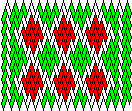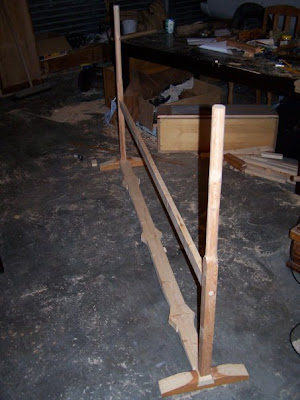"Anglo-Saxon" Belt
UPDATE: it seems this pattern probably isn't Anglo-Saxon after all, but medieval.
 Warp: Red, green and white silk
Warp: Red, green and white silk
Weft: Green silk
Pattern: Woven in diamonds
Cards: 32
Width: 1 - 2.5 cm
Length: 140cm
What's new: not brocade
OK, so this isn't a brocaded pattern. I'm getting more and more keen to try the various non-brocaded techniques and sometime next year I expect I'll drop the "brocaded" from the blog title. Not yet though because I have 3 brocaded bands queued up after this already.
This pattern comes from a belt from Anglo-Saxon Cambridge. It is described on page 122 of Collingwood (2002 edition), page 53 of Hansen and on Þora sharptooth's site. Reproductions by Þora sharptooth and Shelagh Lewins can be seen online.
This pattern was calling out to me at this particular time because like the Mammen band it involves quarter-turning alternating left and right cards. It is the only non-brocaded piece I've done so far other than the basic eight-card chevron/diamond pattern that so many people do for their first ever tablet weaving experience. Although it looks pretty similar to that diamond pattern, it's actually cunningly designed to look the same on both sides. Instead of smooth lines on one side and jagged ones on the other, the jagged edges are spread between both sides so that neither of them look particularly bad.
I wanted to make a belt to donate to the Fighter Auction at Canterbury Faire with this pattern. I decided to increase the width of the pattern by increasing the central section a couple of times.
 It's a bit of a shock to the system going from brocaded to threaded in patterns. When brocading, really the only thing of real signficance (for a somewhat sloppy weaver like myself) is that the brocade has the correct tiedowns. Change the card direction, accidentelly flip a couple of cards on the edge over, change the tension, whatever, it's not going to make a big difference. But with a pattern like this, it's essential the cards stay in configuration. A temporary change in tension can make a very obvious line in the pattern (see around the middle of the picture above). The tension on the individual threads has a major effect on the shape of the diamonds.I wove this band using the new warp spreader made for me by Lowrans Wilyamson, which I will write about in a separate post.
It's a bit of a shock to the system going from brocaded to threaded in patterns. When brocading, really the only thing of real signficance (for a somewhat sloppy weaver like myself) is that the brocade has the correct tiedowns. Change the card direction, accidentelly flip a couple of cards on the edge over, change the tension, whatever, it's not going to make a big difference. But with a pattern like this, it's essential the cards stay in configuration. A temporary change in tension can make a very obvious line in the pattern (see around the middle of the picture above). The tension on the individual threads has a major effect on the shape of the diamonds.I wove this band using the new warp spreader made for me by Lowrans Wilyamson, which I will write about in a separate post.
Because this band was for a belt and people seem to prefer their belts to be wider than 1cm, I did my best to let the band grow to a decent width. Looking back I think this was the wrong call because the resulting band is very loose weave and prone to deforming when pulled perpendicular to the warp . Also, the wider the diamonds the more jagged they look (compare my effort with Shelagh Lewins's effort linked to above. The belt ended up about 2.3cm wide although it took a while to get up there. I didn't cut my warp threads long enough so the widening section is going to have to remain as part of the belt.
To make the belt holes I ran one weft thread through each half of the shed, so there is a slit in the middle. This didn't work all that well due the to low warp density as mentioned above and the band is very uneven in width/tension in this area. It was also hard to make the two sides join up again after each hole without pulling the weft tighter and reducing the width of the band. I did get better at this as I went along. Here's a picture from the start of the hole region where it's at its worst.
 I'm going to put a buckle and ends from Raymond's Quiet Press on the belt.
I'm going to put a buckle and ends from Raymond's Quiet Press on the belt. 
Weft: Green silk
Pattern: Woven in diamonds
Cards: 32
Width: 1 - 2.5 cm
Length: 140cm
What's new: not brocade
OK, so this isn't a brocaded pattern. I'm getting more and more keen to try the various non-brocaded techniques and sometime next year I expect I'll drop the "brocaded" from the blog title. Not yet though because I have 3 brocaded bands queued up after this already.
This pattern comes from a belt from Anglo-Saxon Cambridge. It is described on page 122 of Collingwood (2002 edition), page 53 of Hansen and on Þora sharptooth's site. Reproductions by Þora sharptooth and Shelagh Lewins can be seen online.
This pattern was calling out to me at this particular time because like the Mammen band it involves quarter-turning alternating left and right cards. It is the only non-brocaded piece I've done so far other than the basic eight-card chevron/diamond pattern that so many people do for their first ever tablet weaving experience. Although it looks pretty similar to that diamond pattern, it's actually cunningly designed to look the same on both sides. Instead of smooth lines on one side and jagged ones on the other, the jagged edges are spread between both sides so that neither of them look particularly bad.
I wanted to make a belt to donate to the Fighter Auction at Canterbury Faire with this pattern. I decided to increase the width of the pattern by increasing the central section a couple of times.
Because this band was for a belt and people seem to prefer their belts to be wider than 1cm, I did my best to let the band grow to a decent width. Looking back I think this was the wrong call because the resulting band is very loose weave and prone to deforming when pulled perpendicular to the warp . Also, the wider the diamonds the more jagged they look (compare my effort with Shelagh Lewins's effort linked to above. The belt ended up about 2.3cm wide although it took a while to get up there. I didn't cut my warp threads long enough so the widening section is going to have to remain as part of the belt.
To make the belt holes I ran one weft thread through each half of the shed, so there is a slit in the middle. This didn't work all that well due the to low warp density as mentioned above and the band is very uneven in width/tension in this area. It was also hard to make the two sides join up again after each hole without pulling the weft tighter and reducing the width of the band. I did get better at this as I went along. Here's a picture from the start of the hole region where it's at its worst.


Comments
Post a Comment